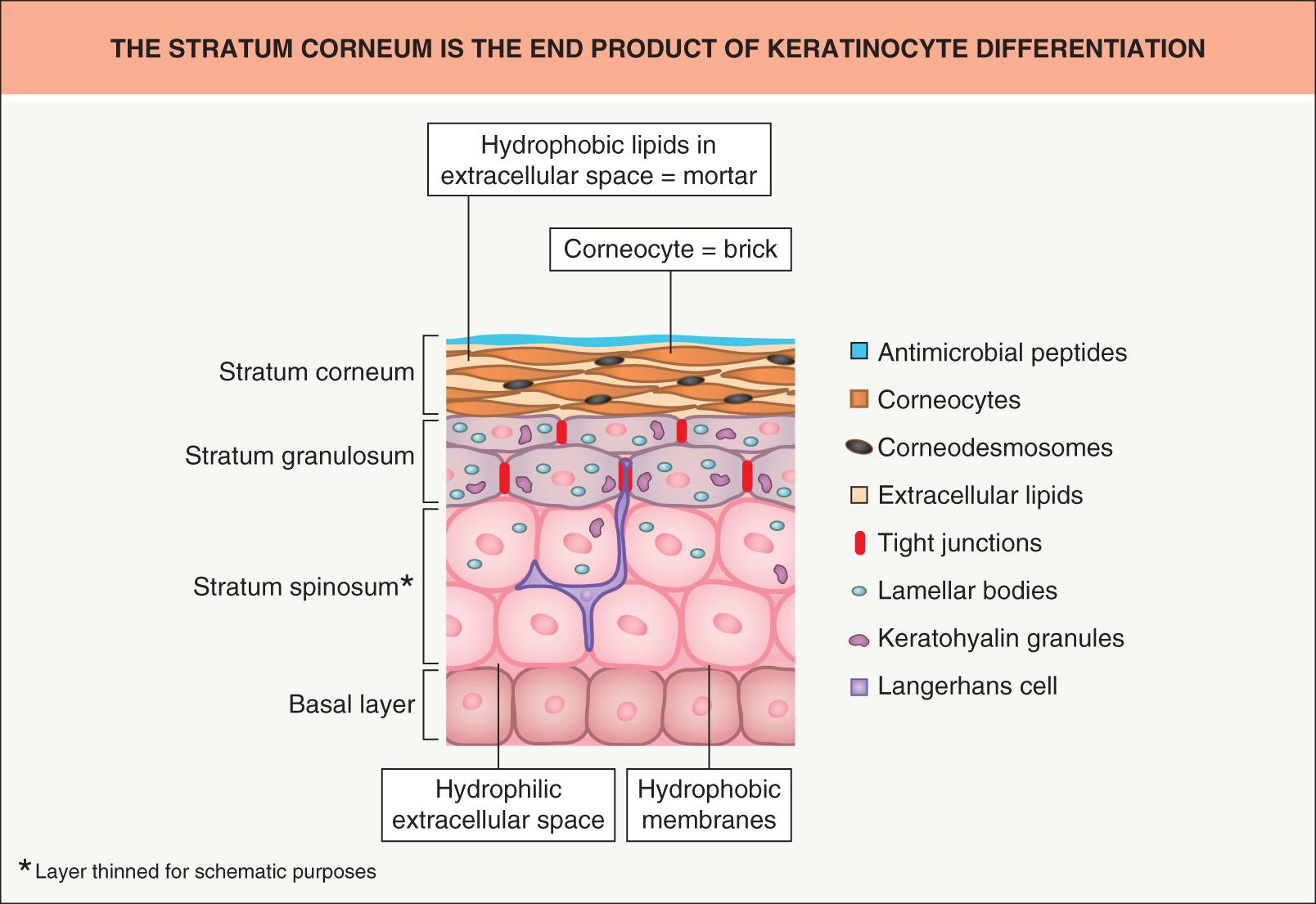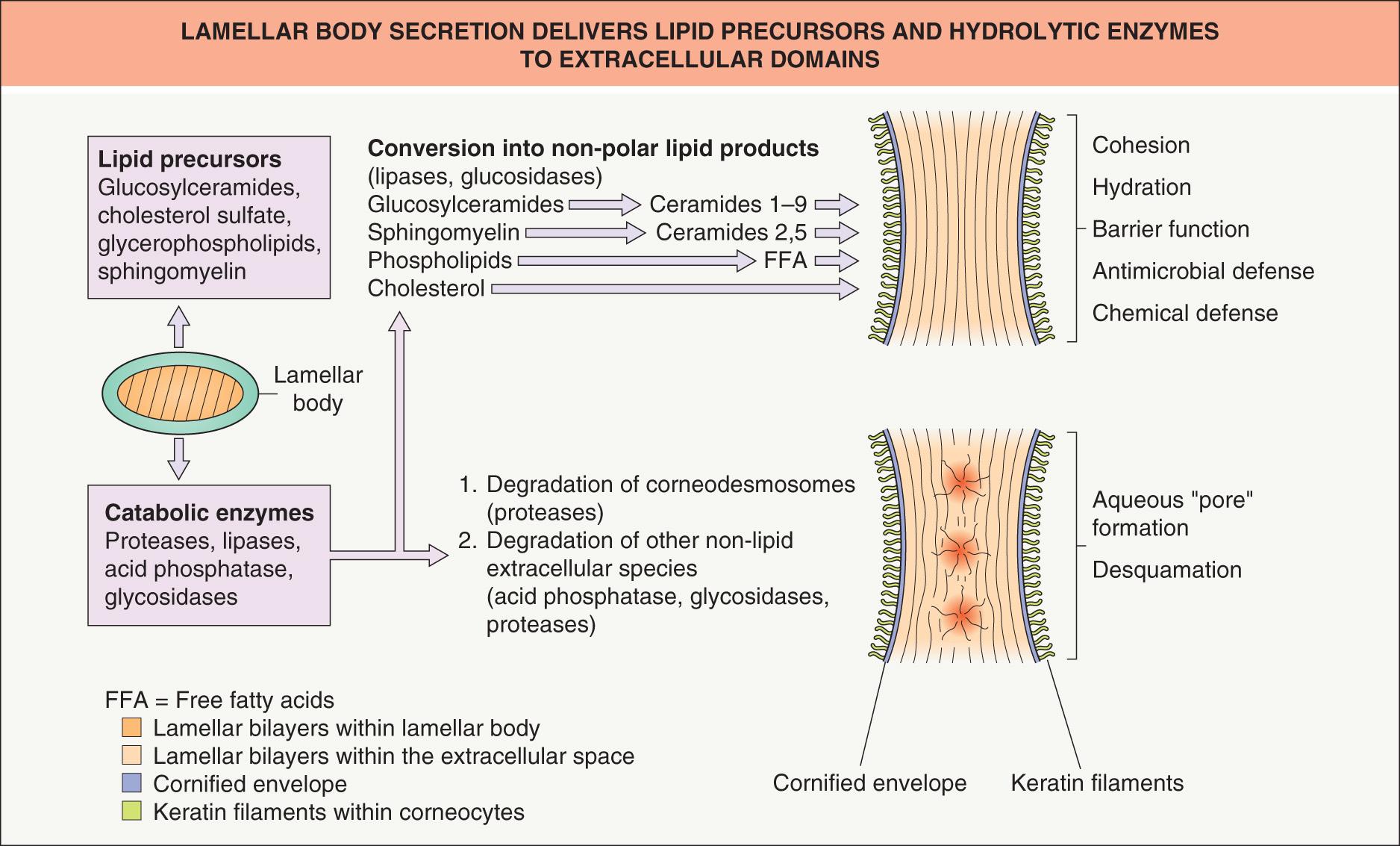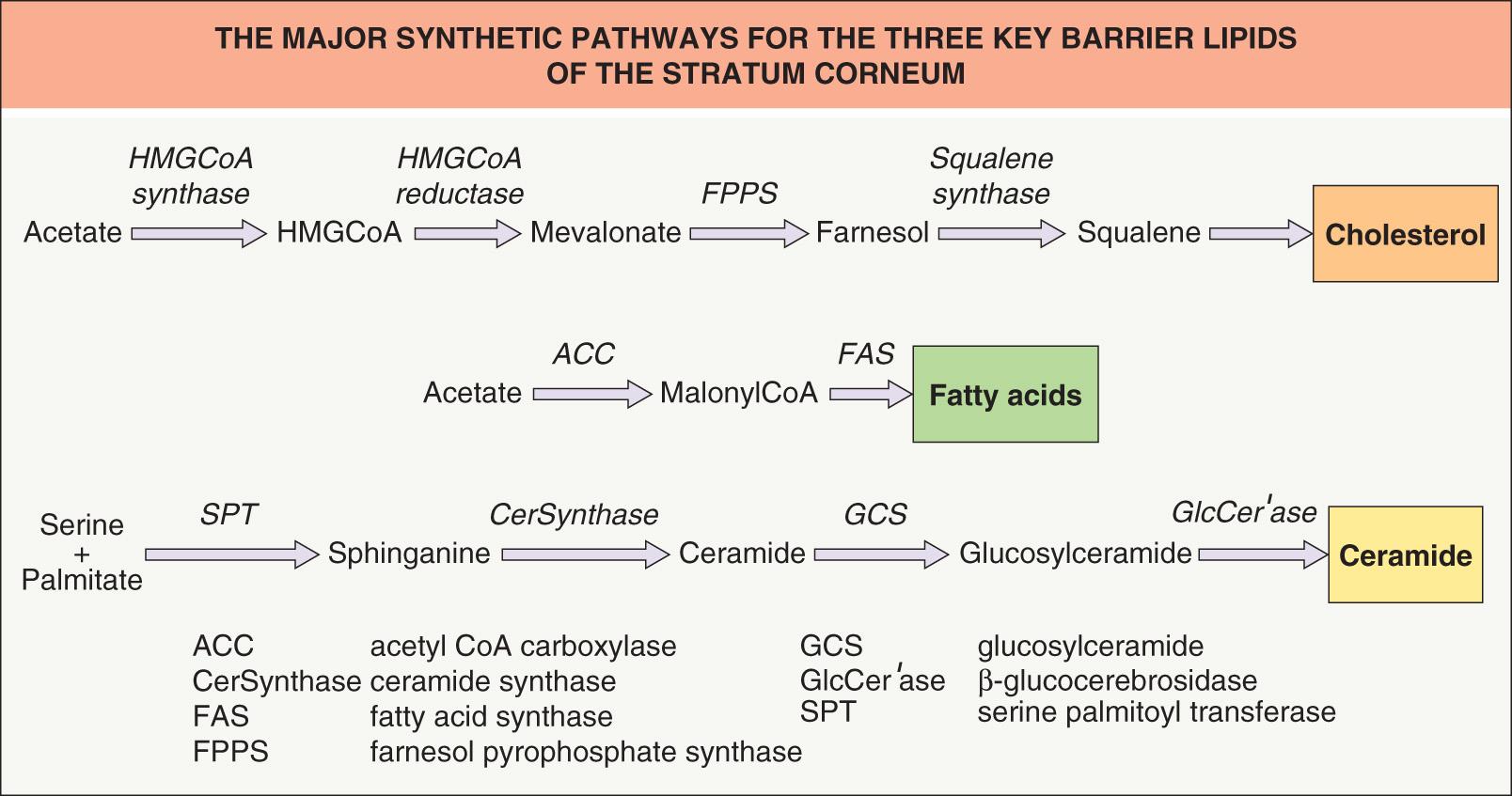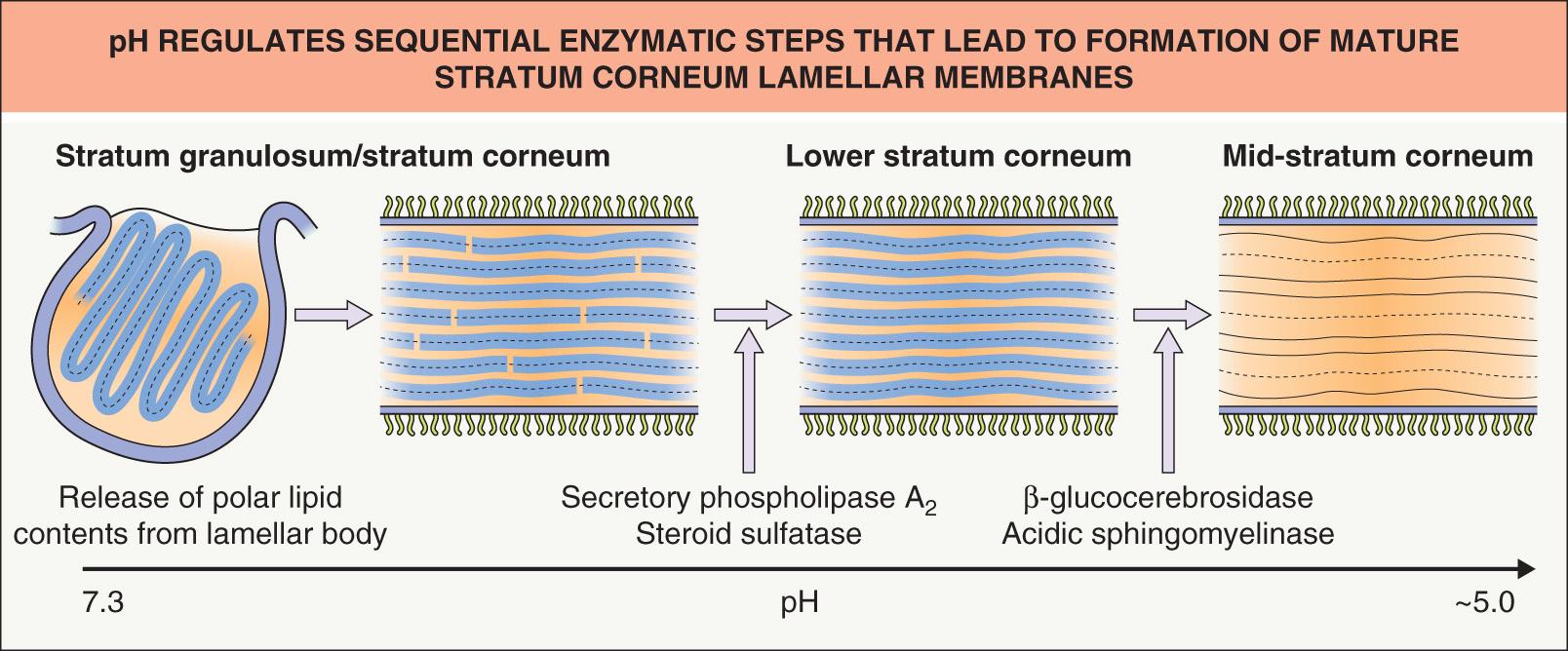Physical Address
304 North Cardinal St.
Dorchester Center, MA 02124
Stratum corneum structure and organization 2176
Epidermal metabolism and the skin barrier 2176
Impaired skin barrier and cutaneous inflammation 2179
The skin provides the largest interface between the human body and the external environment. Therefore, one of its most important functions is to prevent ingress of potentially harmful exogenous substances (outside-in barrier). Likewise, the skin must prevent excessive loss of water and other bodily constituents given that desiccation is incompatible with life (inside-out barrier).
The skin's remarkable barrier properties are due in large part to epidermal homeostasis, which depends on several cell types and function . As they differentiate, keratinocytes accumulate specialized organelles, e.g. lipid-containing lamellar bodies, whose contents play a key role in the formation of the stratum corneum ( Fig. 124.1 ). The corneocytes within the stratum corneum are composed primarily of aggregated keratin filaments encased in a cornified envelope and have been likened to “bricks”. They are surrounded by an extracellular milieu of lipids organized as multiple lamellar bilayers, analogous to “mortar”. These structured lipids prevent excessive loss of water from the body and likewise block entry of exogenous compounds, including many topically applied drugs (except for those that are lipid-soluble and of low molecular weight).

Originally, the skin barrier was thought to be formed solely by lipid secretion and processing . However, more recently it was shown that tight junctions not only play an important role in directly blocking passage of some molecules, but also direct epidermal differentiation and formation of the lipid barrier . Of note, the tight junction barrier develops before the lipid barrier, both in a fetal rat model and in human epidermal equivalents (HEE), and tight junction expression recedes as the lipid barrier develops .
The stratum corneum is a composite material made of proteins and lipids structurally organized as “bricks and mortar” (see Fig. 124.1 ; Table 124.1 ) . Instead of being uniformly dispersed, the highly hydrophobic lipids in normal stratum corneum are sequestered within the extracellular spaces, where this lipid-enriched matrix is organized into lamellar membranes that surround the corneocytes . Hence, rather than stratum corneum thickness, variations in number of lamellar membranes (= lipid weight %), membrane structure, and/or lipid composition provide the structural and biochemical basis for site-related variations in permeability . It follows, then, that the extracellular, lipid-enriched matrix of the stratum corneum comprises not only the structure that limits transdermal delivery of hydrophilic drugs, but also the so-called stratum corneum “reservoir” , within which lipid-soluble drugs (e.g. topical corticosteroids) can accumulate and be slowly released.
| FEATURES OF THE STRATUM CORNEUM |
|
Human stratum corneum is typically comprised of about 20 corneocyte cell layers, which differ in their thickness, packing of keratin filaments, filaggrin content and number of corneodesmosomes, depending on body site. Corneocytes are surrounded by a highly cross-linked, resilient sheath, the cornified envelope, while the cell interior is packed with keratin filaments embedded in a matrix composed mainly of filaggrin and its breakdown products (the latter are also referred to as “natural moisturizing factors”). As noted previously, individual corneocytes, in turn, are surrounded by a lipid-enriched extracellular matrix, organized largely into lamellar membranes, which are derived from secreted lamellar body precursor lipids ( Fig. 124.2 ). Following secretion, lamellar body contents fuse end-to-end, forming progressively elongated membrane sheets , a sequence requiring the action of a battery of lipolytic “processing” enzymes (see below).

The exceptionally low permeability of normal stratum corneum to water-soluble drugs is the consequence of several characteristics of the lipid-enriched, extracellular matrix ( Table 124.2 ) . Moreover, not only the paired-bilayer arrangement of extracellular lipids, but also their extreme hydrophobicity and the composition and distribution of the three key species (ceramides, cholesterol and free fatty acids) in a critical (1 : 1 : 1) molar ratio, are further characteristics that provide for barrier function.
| FACTORS AFFECTING HOW STRATUM CORNEUM LIPIDS MEDIATE BARRIER FUNCTION |
|
Ceramides account for ~50% of the total stratum corneum lipid mass and are crucial for the lamellar organization of the stratum corneum barrier . Of the nine ceramide classes, acylceramides or ceramides 1, 4 and 7 (which contain ω-hydroxy-linked essential fatty acids in an ester linkage) are epidermis-unique compounds, known to be important for barrier function . Cholesterol , the second most abundant lipid by weight in the stratum corneum, promotes the intermixing of different lipid species and regulates its “phase” behavior . Free fatty acids , which account for 10–15% of stratum corneum lipids, consist predominantly of very-long-chain, saturated species with ≥18 carbon atoms. A decrease in the concentrations of any of these critical lipid species compromises barrier integrity due to alteration of the molar ratio of the membranes that mediate normal barrier function.
Epidermal differentiation is a vectorial process that is accompanied by dramatic changes in lipid composition, including loss of phospholipids with the concomitant emergence of ceramides, cholesterol and free fatty acids in the stratum corneum (see Fig. 124.2 ). Although epidermal lipid synthesis is both highly active and largely autonomous from systemic influences, it can be regulated by external influences, i.e. changes in the status of the permeability barrier . Acute perturbations of the permeability barrier stimulate a characteristic recovery sequence that leads to restoration of normal function over about 72 hours in young skin (the cutaneous stress test). This sequence includes an increase in cholesterol, free fatty acid and ceramide synthesis that is restricted to the underlying epidermis and is attributable to a prior increase in mRNA and enzyme activity/mass for each of the key synthetic enzymes ( Fig. 124.3 ). Furthermore, synthesis of each of the three key lipids is required for normal barrier homeostasis in that topically applied inhibitors of the key enzymes in each pathway produce abnormalities in permeability barrier homeostasis .

The unique two-compartment organization of the stratum corneum is attributable to the secretion of lamellar body-derived lipids and co-localized hydrolases at the stratum granulosum–stratum corneum interface . Under basal conditions, lamellar body secretion is slow, but sufficient to provide for barrier integrity. Following acute barrier disruption, calcium is lost from the outer epidermis and much of the preformed pool of lamellar bodies in the outermost cells of the stratum granulosum is quickly secreted . Calcium (Ca 2+ ) is an important regulator of lamellar body secretion, with the high levels of Ca 2+ in the stratum granulosum restricting lamellar body secretion to low, maintenance levels .
Extrusion of the polar lipid contents of lamellar bodies at the stratum granulosum–stratum corneum interface is followed by the processing of those lipids into more hydrophobic species that form mature lamellar membranes ( Fig. 124.4 ). The extracellular processing of glucosylceramides, phospholipids and cholesterol sulfate resulting in the accumulation of ceramides, free fatty acids and cholesterol within the stratum corneum is attributable to the co-secretion of a set of hydrolytic enzymes (see Fig. 124.2 ).

Extracellular processing of glucosylceramides plays a key role in barrier homeostasis (see legend to Fig. 124.3 ). In addition, phospholipid hydrolysis, catalyzed by one or more secretory phospholipases (e.g. sPLA 2 ), generates a family of nonessential free fatty acids, which are also required for barrier homeostasis . Since applications of either bromphenacylbromide or MJ33 (chemically unrelated sPLA 2 inhibitors) modulate barrier function in intact skin, sPLA 2 appears to play a critical role in barrier homeostasis . Moreover, applications of either inhibitor to perturbed skin sites delay barrier recovery.
Sphingomyelin hydrolysis by acidic sphingomyelinase generates two of the nine ceramides required for normal barrier homeostasis (see Fig. 124.2 ). Moreover, patients with mutations in the gene encoding acidic sphingomyelinase that lead to low enzyme activity (Niemann–Pick, Type A) display an ichthyosiform dermatosis, and transgenic mice with an absence of acidic sphingomyelinase also demonstrate a barrier abnormality. Finally, applications of nonspecific inhibitors of acidic sphingomyelinase to perturbed skin sites lead to a delay in barrier recovery .
Just as with glucosylceramides and sphingomyelin, cholesterol sulfate content increases during epidermal differentiation, and then decreases progressively as the latter is desulfated during passage from the inner to the outer stratum corneum . Both cholesterol sulfate and its processing enzyme, steroid sulfatase, are concentrated in membrane domains of the stratum corneum. Of note, the content of cholesterol sulfate in these sites is increased by ~10-fold in recessive X-linked ichthyosis (see Ch. 57 ) . Not only is recessive X-linked ichthyosis characterized by a barrier defect , but repeated applications of cholesterol sulfate to intact skin can produce a barrier abnormality . In both cases, the barrier abnormality is attributable to cholesterol sulfate-induced phase separation within lamellar membrane domains . But the barrier defect may also be, in part, attributed to a reduction in cholesterol content, since cholesterol sulfate is a potent inhibitor of HMG-CoA reductase (see Fig. 124.3 ).
In addition to lipid precursors and hydrolytic enzymes (e.g. steroid sulfatase, acidic sphingomyelinase), lamellar bodies contain proteases and antiproteases that orchestrate the orderly digestion of corneodesmosomes, allowing corneocyte shedding. These organelles also release antimicrobial peptides, including human β-defensin 2 and LL-37 (the carboxy-terminal fragment of human cathelicidin).
Become a Clinical Tree membership for Full access and enjoy Unlimited articles
If you are a member. Log in here